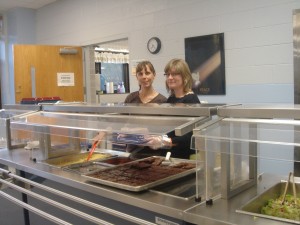
Cullowhee Valley School PTA members working at the “Spring Fling 2012” fundraiser for the school. Photo WCJ
Since the economic downturn of 2008, state and federal budgets have been re-worked and reduced, in the hopes of saving money while still funding important public programs such as education.
Although funding for public education has always been an issue of public debate, as budgets were reduced across the board, education has taken some of the largest cuts. According to the US Census Bureau, there are 82 million children over the age of three enrolled in public education; therefore, budget cuts have a vast effect.
In the 2011-2012 school year, $459 million from North Carolina’s public school budget was cut from state funding. For 2012-2013, an additional $1 billion is to be cut. This translates into a 9.3% reduction in state funding for public education over two school years.
Melissa Wargo, president of the Cullowhee Valley Elementary Parent Teacher Association (PTA) explained that bigger class sizes are the first notable effect of the budget cuts.
“The first impact of budget cuts is often a drift towards increasing class sizes because it’s easy and you can do this without cutting existing personnel. Do more with less is not always a good model for schools,” said Wargo.
Wargo explained that at Cullowhee Valley, the PTA has allocated over $16,000 in the past two years for digital projectors and smart boards. The PTA has also used over $6,000 to supplement teacher supplies.
“Cuts have put schools in the position of relying on parents to directly fund supplies and technology in the classrooms, but this creates inconsistencies not only across schools and school districts, but within grade levels at the same school,” said Wargo.
North Carolina Policy Watch (NC Policy Watch), a progressive non-profit organization hoping to influence the ways in which politicians make decisions, produced a chart in which they outlined ways where North Carolina could produce the funds to cut from the education budgets.
One of the ways that NC Policy Watch suggests creating revenue for public education, is to apply a state sales tax on all consumer services, and reducing the current tax rate from 4.75% to 3.85%. This would generate an estimated $640 million and would ensure that class sizes would remain the same, and over 14,500 teaching jobs would not be cut.
NC Policy Watch goes on to propose a 3% personal income tax on households with a joint taxable income above $250,000 (above $150,000 for single). If implemented, this would generate an approximated $79 million that could be used to fund public education.
This article from NC Policy Watch points out concerns that many people have; that there are ways in which the funding for public education can be raised, without the loss of teacher jobs and increased classroom sizes.
For new teachers, the challenges they face in the classroom are just another thing that they have on their plate. For Will Freeman, a senior at Western Carolina University who is currently student teaching music education at Waynesville Middle School, that means he will most likely encounter financial troubles at his permanent school.
“At Waynesville Middle, they are very fortunate to have had the same band director for almost thirty years, who has been able to fight for more funding and has been able to make the band self-sufficient through fundraising projects,” said Freeman.
This is just the exception though. Often times, the first programs to get cut at schools are the arts, which studies have shown are the most important.
“Many schools do not have any money for the arts and aren’t funded through the state or the county,” explained Freeman. “Money for instrument repairs just isn’t there.”
Wargo, who has a child in kindergarten at Cullowhee Valley, realizes that teachers need more support, and not just in terms of paper and markers.
“Because budgets in educational institutions tend to be tied heavily to personnel, cuts often disproportionately impact operational areas first,” said Wargo. “It’s easier to cut dollars for teacher development than it is to eliminate a person, but over time this can have a hefty detrimental effect on teachers being able to deliver the best education to our children.”
The North Carolina Center for the Advancement of Teaching (NCCAT), a leader in educating teachers, felt the same burden that schools felt this past year. Last year, over half of their $6 million budget was cut, resulting in a reduction of half of their staff, many training seminars and reduced attendance in seminars.
As the PTA president and parent of a student at Cullowhee Valley, Wargo explains that extra funding for schools ensures that students have essentials in the classroom.
“Honestly, before I was PTA president, I thought PTA fundraising was to fund the nice ‘extras’ for a school like new playground equipment or sports equipment. I was dismayed to find that our school, like many others, now relies heavily on PTA dollars to fund critically important things like supplies and technology.”
Even though the economic turndown may be over, the consequences of budget cuts in education across North Carolina and the country alike, are large, and will not be fixed immediately. Moving forward, education is an important social program that cannot withstand future budget cuts.



